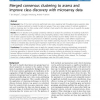37 search results - page 1 / 8 » Automatic Cluster Number Selection Using a Split and Merge K... |
DEXAW
2009
IEEE
13 years 11 months ago
2009
IEEE
Abstract—The k-means method is a simple and fast clustering technique that exhibits the problem of specifying the optimal number of clusters preliminarily. We address the problem...
ICASSP
2011
IEEE
12 years 8 months ago
2011
IEEE
We propose a methodology for improved segmentation of images in a Bayesian framework by fusion of color, texture and gradient information. The proposed algorithm is initialized by...
BMCBI
2010
13 years 2 months ago
2010
Background: One of the most commonly performed tasks when analysing high throughput gene expression data is to use clustering methods to classify the data into groups. There are a...
ADMA
2007
Springer
13 years 11 months ago
2007
Springer
This paper uses an optimization approach to address the problem of conceptual clustering. The aim of AGAPE, which is based on the tabu-search meta-heuristic using split, merge and ...
ICPR
2008
IEEE
13 years 11 months ago
2008
IEEE
A split-and-merge framework based on a maximum variance criterion is proposed for disparity clustering. The proposed algorithm transforms low-level stereo disparity information to...

